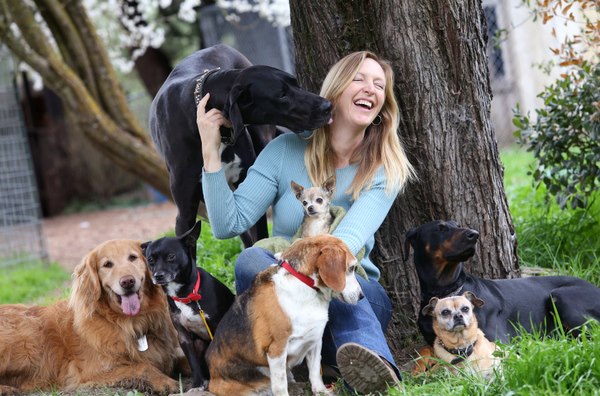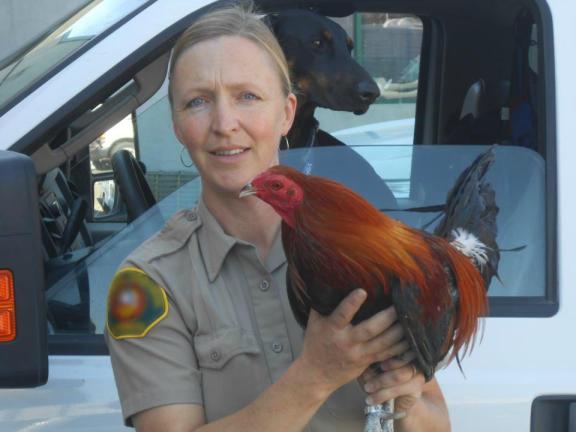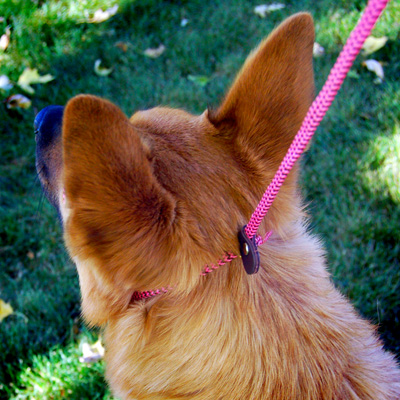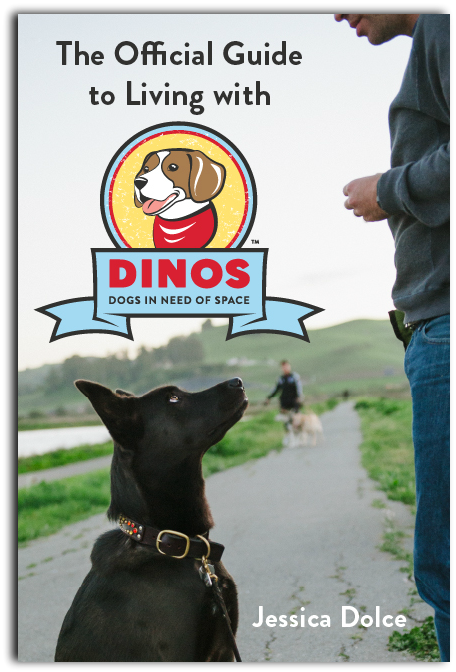Some days, you just don’t want to walk your DINOS.
Maybe it’s because the weather is terrible, like the freezing rain we had here in Maine last week, or it might be because your neighborhood is filled with off leash dogs that terrorize you on your walks. Most of the time, we still grab our leashes and hit the streets, but there are some days we could all use a break.
So whether you’re looking for a safe way to exercise your DINOS without running into other dogs or you just want to avoid extreme weather, here’s a bunch of great ideas for indoor fun from Team DINOS on Facebook!
To get us started, here are some of my favorite ways to wear out dogs inside the house:

Treadmills: They can be total lifesavers for DINOS. With a treadmill you can safely exercise your DINOS in your home, with no other dogs to contend with, whenever your dog needs it. You can use the treadmill you already have, purchase a used one for cheap off of Craig’s List, or a buy treadmill specifically designed for dogs. Here’s some advice from Bad Rap for getting started with a dog-powered (no motor) treadmill.
Puppy Push Ups: Sit, down, sit, down, sit, down. Easiest “trick” in the book. It helps burn off a little energy, even if your dog only knows two commands!
Feeding all Meals from Frozen Kongs: If your dog has a lot of energy, I would suggest chucking your dog bowls all together and only feeding from dog puzzles. Firecracker Dogs has some great articles on this and a store filled with puzzles that are worth checking out. If you’re using Kongs, try freezing them, since it’ll take much longer for your dogs to work out their meal, burning more mental and physical energy in the process.
Rile/Recovery work with a Flirt Pole: You can go the homemade route or buy a premade “chase it” toy, but either way, if you have a dog that loves chasing stuff (and has healthy joints), this giant cat toy will rock their world and burn a ton of energy. What’s key to this? Your dog must know basic commands such as: sit, down, wait, take it and drop it for this to be a safe, fun game. If you want to do this inside, get a smaller 2-3 foot flirt pole, for outside, you can go big! Before you try it, take a look at this video from Bad Rap and read this how-to.
Heavy Duty Chew Toys and Bones: Some dogs can work out an incredible amount of energy through chewing on toys and bones. Particularly helpful for barkers, to wear out those overactive jabber jaws.
Those are some of my faves, but don’t stop here, check out all the great suggestions from the rest of the group (keep in mind that all dogs are individuals and what works for some, may not be the best choice for others):
Heather Masch Nosework is a great activity to do indoors.
Juli Thompson Casey and I play hide and seek. She has to sit and stay while I go into another room, or closet, maybe hide behind a curtain. When I yell “come,” she has to follow my voice to find me. Body and brain both get exercised, and it reinforces “come,” which is still a problem command for us.
Lori Fricks I throw a tennis ball up the stairs, Marshall chases up after it and brings it back down for another go! We also play tug until my arms go numb!
Jo Maisey I do some clicker training to tire out their brains.
Ashley Oslund Laser light in small doses!
Kim Kusznir Odin likes to jump in the air and pop bubbles!
Alexis Bywater Laser pointer!! Keep “dot” sessions short and sweet! 10 minutes with the laser pointer can be a great workout (I combine obedience work with laser play which is a great way to proof commands on a really amped up dog).
Kristel Smart I live on the fourth floor of an apartment building and our stairs are indoors and carpeted. The stairway tends to be pretty deserted (most people prefer the elevator) so I practice send-aways and emergency stops and downs while I have Murphy run up and down the stairs (he has great hips and he’s young). When he’s tired out I let him relax with a good rib-bone.
Kelsey Gidley We play the box game, dinner from puzzle toys and lots and lots of tug.
Suzan Toscano Tug toys & balls thrown down the hall to be retrieved.
Julie Parker Rmdt We play “tag” in the living room. We also like the Kong Wobblers for mental stimulation.
Kathie McDermid Dierk Throw the ball, throw the ball, throw the ball…and then maybe “find it” (he sits in another room, I take a treat, hide it (like in a drawer or something) and then release him to “search”)
Kendra Roering Treadmill!
Jennifer Whitton-Trujillo We throw the ball (or whatever other toy Colby brings), but I love throwing it down the stairwell, so he has to run up and down stairs. Wears him out much better than just tossing it down the hall!
Jessie Copeland We play fetch in our kitchen with light plastic balls or a Kong frisbee, trying to continue basic drop, sit, stay, and other commands. Dash LOVES this game!
Judy Michaels Living Room Rally! My fave: One dog becomes a post, and a little yellow cone the other. Great way to work on Figure 8s and distraction work!
Barbara Lewis I don’t have stairs, so I set up a makeshift agility jump (broom held up about 6 inches off the ground by stacked books or whatever else) – then I toss pieces of dog food across the room so she has to run and jump over the hurdle to get it. It’s sort of ridiculous, but it works!
Laurie James Buchele Puzzle toys, brain games, tricks.
Laura Pescador Misha has the big egg-shaped FitPaws ball for strength and stretching, nosework, recall games with one human holding her and the other hiding, the big box home improvement store up the street still allows dogs (early on a weekday before work there aren’t a lot of other dogs), lots of training games like calling heel from anywhere in the house.
Brooke Palmer Lots of puzzles and messing around with the clicker to see what I can try to get my dog to do.
Violet Elder Run her up and down the stairway.
Celeste Schmidt We’ve had an oddly warm winter this year, but usually good ol’ tug, some shaping, nosework, and treadmill are  what help. I’ve also had to jog in circles inside the house, usually I’ll have the dogs come along with me.
what help. I’ve also had to jog in circles inside the house, usually I’ll have the dogs come along with me.
Michelle Doram K9 Nose Work!
A Better Life with Your Dog with Fernando Camacho I have done a number of sessions with dogs that become obsessive shadow chasers because of laser pointers, so my favorite indoor fun is bubbles. My dog will jump and pop them for hours. Great exercise!
Laura Elizabeth Mine loves to play tug game, so we play tug of war and some fetch inside.
Jill Michalski Hide n’ Seek, “Find it”, Kong Wobbler, and sometimes a bit of “doggie boot camp” practicing sit/downs (like doing pushups), stay, wait, place, etc.
Jennene Lausier My dog loves our treadmill! It’s his favorite!
Kris Hopkins My last German Shepherd police K9 was the “diggiest dog”. To channel it in non-destructive ways I bought him a small, thin heavy-duty crate bed and let him scratch it from one end of the room to the other. He was totally winded scratching at that scratchy pad for hours! When we could go outside, he got a sand box and it was the “dig patch”. All other areas were off-limits for digging or scratching. It worked and his front legs were unbelievably strong!
Jackie Hall-Reigle I had bought a treadmill for him and surprisingly he got right on it! He loves it, and when he hears it start, he comes running to get on it.
Sarah Power We hide toys while she waits in another room. We put the toy in a taped up box so she has to get it open, also bring out the agility tunnel to jump over and hide stuff under laundry baskets. Mental stimulation goes a long way, she doesn’t get tired without it.
Anne Davidson Indoors treiball (learn to get it out of corners); jump over boxes, legs both directions for fetch a toy. Sit and watch me hide toys (in sight at this point), then go fetch and put each one in the box. Boxes within boxes; prize inside smallest.
Jessica Healy We play fetch and chase up and down the stairs and also brain games.
Bonnie N. Davis Leo’s still too reactive to play inside, but has a mega thick coat, so he gets lots of trips outside during the day. But when he comes in or if it’s too frigid for him to stay out, he gets a huge bone or toy to chew.
Heather Staas Indoor frisbee with lids!
Lynda McLellan Susan Garrett’s Recallers (online classes) is all about games and most can be played in doors. Teaches self-control and focus while having lots of fun. I also use a Kong wobbler and hide and seek, which my son loves to play with the dogs along with Recaller games.
Danielle Cyr Nose works! Only need one room and my household junk! We also do small space shaping for competitions like retrieves, positions, rear end awareness. Keeps their brains warm!
Martha Knowles For some indoor thinking games and great ways to bond with your dog Playtime for Your Dog: Keep Him Busy Throughout the Day by Christina Sondermann
Jill Petro After tossing a toy or ball for a while, my dog is placed on a stay in another room while I hide the toy. Then I ask him to find it. Makes him use his brain!
Chris Jones We play hide ‘n’ go seek. I put my dog on stay and go hide then I call him. Sometimes he can’t find me and is extra overjoyed when finds me.
Cheryl Copenhagen Set up jumps or the tunnel and throw Kirby’s toys so that he has to jump over or go through!
Nicole De La Per relle I pull out a couple of books and try to teach something new! Kyra Sundance’s books are good for this, so the other week (when it was hot here in Australia- over 40 degrees Celsius), I put treats in a few cups of a muffin pan and then put a tennis ball into each cup of the pan, so the dogs have to sniff out the treats, then use their nose or paw to push the ball out to get the treat. We also play “fishing” by hooking up a toy on a string to a stick and then flicking it around, getting the dog to chase it, try to catch it etc. You can buy toys like that or use a cat toy (Max loves the feather boa on a stick type of cat toy) or make your own. We also play “rev up and calm down” as part of the inside games. We get the dogs really excited about the game, but then ask for a sit or a drop and wait for a bit of calm before continuing. This stops the games from getting too intense and the dogs from getting too excited. It’s really hard work so wears them out more!
relle I pull out a couple of books and try to teach something new! Kyra Sundance’s books are good for this, so the other week (when it was hot here in Australia- over 40 degrees Celsius), I put treats in a few cups of a muffin pan and then put a tennis ball into each cup of the pan, so the dogs have to sniff out the treats, then use their nose or paw to push the ball out to get the treat. We also play “fishing” by hooking up a toy on a string to a stick and then flicking it around, getting the dog to chase it, try to catch it etc. You can buy toys like that or use a cat toy (Max loves the feather boa on a stick type of cat toy) or make your own. We also play “rev up and calm down” as part of the inside games. We get the dogs really excited about the game, but then ask for a sit or a drop and wait for a bit of calm before continuing. This stops the games from getting too intense and the dogs from getting too excited. It’s really hard work so wears them out more!
Virginia HappyGirl Johnson We run up and down the stairs. She made up that game when she got the “zoomies” one night, and we’ve played it ever since.
Alison Garfat On the rare day we don’t get at least a bit of outside time, Monty gets to learn a new trick – over the last couple of stretches of bad weather he’s learned “back up”, opening a cupboard door (“open”) and closing a cupboard door (“push”). Luckily he’s too short to reach the cookie cupboard! Playing “find it” is also a bad weather staple.
Thanks for sharing everyone!



































 what help. I’ve also had to jog in circles inside the house, usually I’ll have the dogs come along with me.
what help. I’ve also had to jog in circles inside the house, usually I’ll have the dogs come along with me. relle I pull out a couple of books and try to teach something new!
relle I pull out a couple of books and try to teach something new! 





